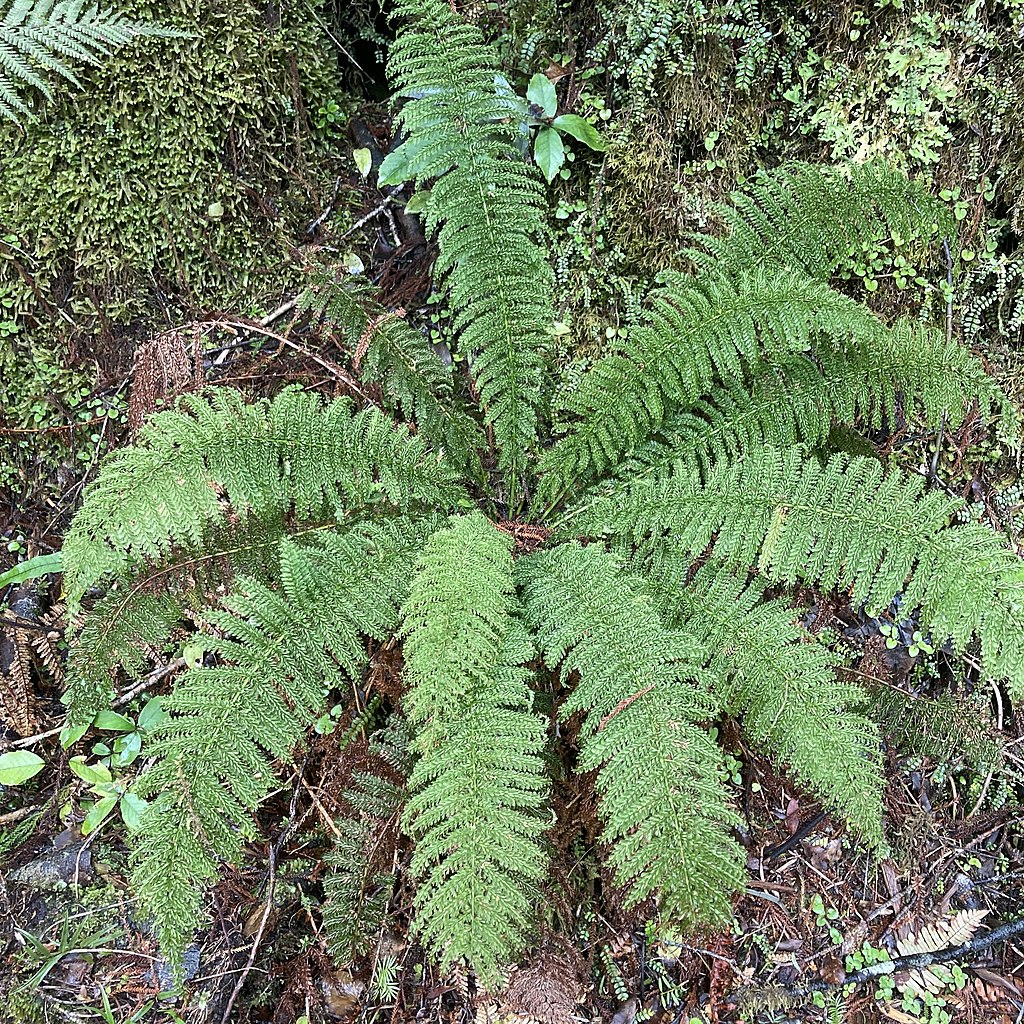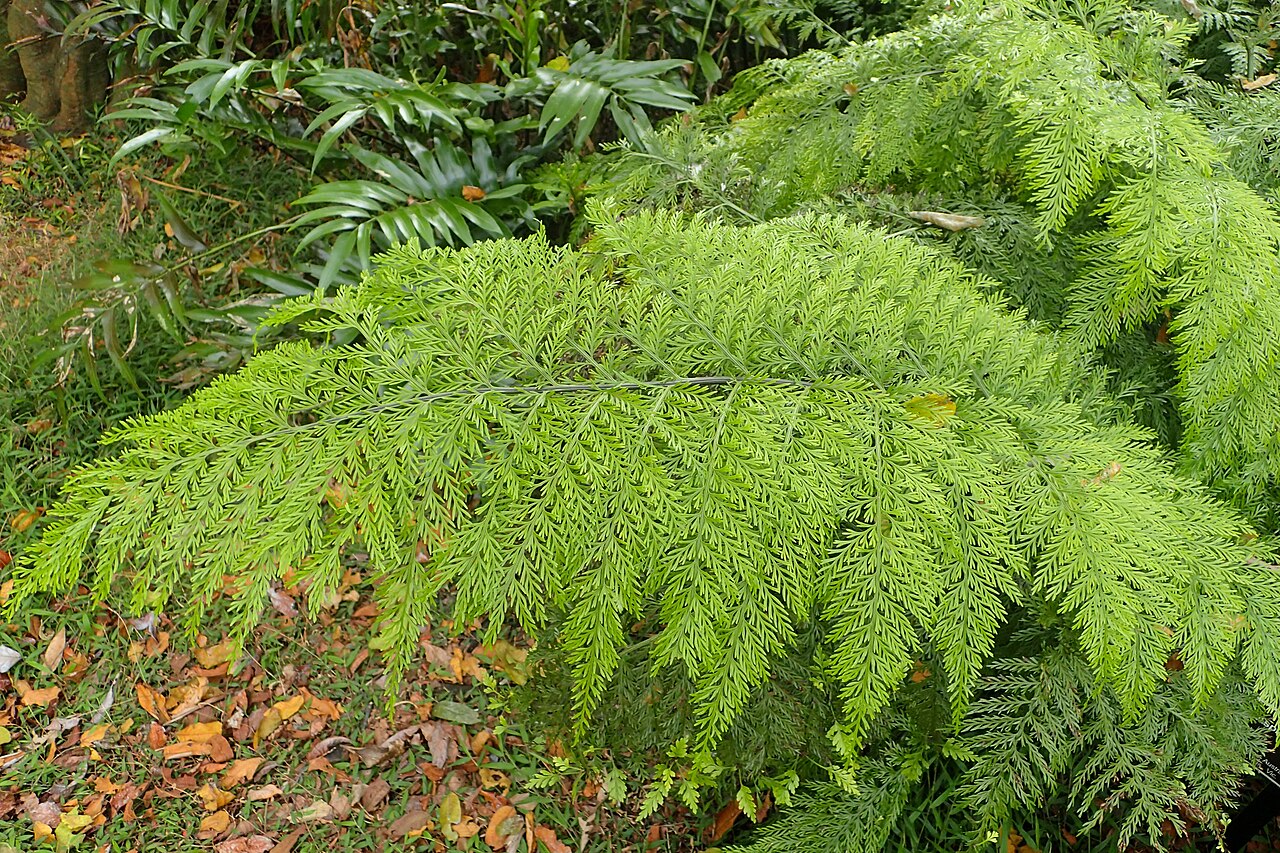Feather Fern
Leptopteris superba
Leptopteris superba, commonly known as Feather Fern, is one of New Zealand's most spectacular native ferns. With its delicate, feathery fronds that have a distinctive translucent appearance, this fern creates an ethereal presence in the damp, shaded environments of New Zealand's native forests. Unlike many ferns, its fronds have a unique filmy texture that gives them a crystalline appearance when wet.

Image credit: Wikipedia
Quick Facts
| Height | 0.5-1.5 meters |
|---|---|
| Water Needs | High |
| Light | Deep shade to filtered light |
| Frost Tolerance | Moderate |
| Growth Rate | Slow |
| Lifespan | Long-lived perennial |
Climate Best Suited To
Feather Fern naturally occurs in cool, damp, shaded environments in New Zealand's native forests. It thrives in areas with high rainfall, consistent humidity, and protection from direct sunlight and wind. It is most common in montane and subalpine forests.
Regional Suitability
| City | Climate Suitability |
|---|---|
| Whangārei | Challenging |
| Auckland | Challenging |
| Hamilton | Moderate |
| Tauranga | Challenging |
| Rotorua | Ideal |
| Gisborne | Challenging |
| New Plymouth | Moderate |
| Napier | Challenging |
| Whanganui | Moderate |
| Palmerston North | Moderate |
| Wellington | Moderate |
| Nelson | Ideal |
| Christchurch | Moderate |
| Dunedin | Ideal |
| Invercargill | Ideal |
Growing Requirements
Soil Requirements
Feather Fern performs best in the following soil conditions:
- Rich, humus-filled soil with high organic content
- Consistently moist but not waterlogged
- Well-draining yet moisture-retentive
- Slightly acidic pH (5.5-6.5)
- Similar to natural forest floor conditions
Light Requirements
This fern requires specific light conditions to thrive:
- Deep shade to filtered light
- Protection from direct sunlight, which can scorch fronds
- Ideal locations include south-facing aspects or under dense tree canopy
- Morning light with afternoon shade can work in cooler regions
- Consistent dappled light mimics its natural forest habitat
Water Requirements
Consistent moisture is critical for this fern:
- Keep soil consistently moist but not waterlogged
- Regular watering, especially during dry periods
- Benefits from high atmospheric humidity
- Misting fronds regularly helps maintain humidity
- Mulching helps retain soil moisture
Temperature Tolerance
Feather Fern prefers cool conditions:
- Thrives in cool, temperate climates
- Optimal temperature range: 10-20°C (50-68°F)
- Can tolerate light frosts when established
- Struggles in hot, dry conditions
- Protection from hot, drying winds is essential
Planting Guide
Timing
Plant in autumn or spring when temperatures are mild and rainfall is more reliable. Avoid planting during hot summer periods or during frost risk in winter.
Location Selection
Choose a sheltered, shaded position protected from wind and direct sunlight. North-facing slopes (in the Southern Hemisphere) or areas under established trees are ideal. Ensure the area has good air circulation but is protected from drying winds.
Soil Preparation
Prepare the soil by incorporating plenty of organic matter such as leaf mold, well-rotted compost, or peat substitute. Create a woodland-like soil that is rich in humus. Ensure good drainage while maintaining moisture-holding capacity.
Planting
Dig a hole twice the width of the root ball and at the same depth. Position the fern so the crown is level with the soil surface. Backfill with prepared soil, firming gently around the roots. Water thoroughly after planting.
Mulching
Apply a 5-7cm layer of organic mulch such as leaf litter, pine needles, or bark chips around the plant, keeping it away from the crown to prevent rotting. This helps maintain soil moisture and mimics the fern's natural forest floor habitat.
Initial Care
Water regularly for the first few months until established. Consider installing a drip irrigation system for consistent moisture. Protect from extreme weather conditions during the establishment period.
Seasonal Care Calendar
Spring Care (September-November)
- Monitor new growth and protect tender fronds from late frosts
- Apply a slow-release organic fertilizer formulated for ferns
- Increase watering as temperatures rise and growth accelerates
- Remove any damaged or dead fronds from the previous season
- Check for pests and diseases as growth begins
- Top up mulch if needed to maintain soil moisture
Summer Care (December-February)
- Maintain consistent moisture levels, watering deeply when needed
- Mist fronds regularly to increase humidity, especially during hot periods
- Provide additional shade if necessary during the hottest part of the day
- Monitor for signs of heat stress or sunburn on fronds
- Avoid fertilizing during very hot weather
- Check regularly for pests like scale insects or slugs
Autumn Care (March-May)
- Reduce watering as temperatures cool and growth slows
- Apply a fresh layer of mulch to protect roots during winter
- Plant new specimens as conditions become favorable
- Collect and sow spores if propagation is desired
- Protect from early frosts if necessary
- Clean up fallen debris around plants to prevent disease
Winter Care (June-August)
- Reduce watering but don't allow soil to dry out completely
- Protect from heavy frosts with frost cloth if necessary
- Avoid disturbing the plant during dormancy
- Check occasionally for water pooling which could cause root rot
- Plan for division or new plantings in spring
- Enjoy the evergreen beauty during the winter months
Propagation Methods
Spores
Propagating from spores requires patience and specific conditions:
- Collect fertile fronds when spore cases turn brown but before they open
- Place fronds on clean paper in a dry place to release spores
- Prepare a sterile growing medium of peat and perlite
- Sprinkle spores thinly over the surface
- Cover with glass or plastic to maintain humidity
- Keep at 18-21°C (65-70°F) in indirect light
- Mist with distilled water to maintain moisture
- Prothalli (small green heart-shaped structures) will form in 1-3 months
- Young ferns will develop in 6-12 months
- Transplant when several fronds have formed
Division
Division is more reliable but should be done carefully:
- Best performed in early spring as new growth begins
- Carefully remove the plant from its pot or garden position
- Gently tease apart the rhizomes, ensuring each division has several fronds
- Use a sharp, sterilized knife if necessary
- Trim any damaged roots or fronds
- Replant divisions immediately at the same depth as before
- Water thoroughly and keep consistently moist
- Provide extra humidity and shade until established
- Avoid fertilizing for at least a month after division
Tissue Culture
For conservation and commercial propagation:
- Requires laboratory conditions and specialized equipment
- Small sections of tissue are grown on sterile nutrient medium
- Used primarily by botanical gardens and commercial nurseries
- Not practical for home gardeners
- Produces genetically identical plants
- Important for preserving rare forms or cultivars
Cultural History
Leptopteris superba has an interesting cultural history in New Zealand:
Traditional Māori Knowledge
- Known as "heruheru" or "piupiu" in te reo Māori
- Not extensively used for medicinal or practical purposes
- Valued for its beauty and as an indicator of healthy forest ecosystems
- Considered a taonga (treasure) of the forest
European Discovery and Naming
- First described by European botanists in the 19th century
- Named "superba" for its superb, delicate appearance
- The common name "Feather Fern" refers to its resemblance to the feathery appearance of the fronds
- Became a popular subject for Victorian-era fern collectors and botanical illustrators
Conservation Status
- Not currently threatened in the wild
- Protected in national parks and conservation areas
- Vulnerable to habitat loss and climate change
- Sensitive to changes in forest microclimate
Contemporary Significance
Today, Feather Fern is valued as one of New Zealand's most beautiful native ferns. It represents the unique biodiversity of New Zealand's temperate rainforests and is a highlight for visitors to native forest areas. In horticulture, it is prized by fern enthusiasts and collectors, though its specific growing requirements make it a challenging but rewarding species to cultivate.
Pests & Diseases
Common Pests
- Slugs and Snails: Can damage fronds, especially new growth. Use organic slug baits, copper tape barriers, or beer traps.
- Scale Insects: May appear on fronds as small bumps. Remove with cotton swab dipped in alcohol or use horticultural oil.
- Mealybugs: Occasionally infest the crown and base of fronds. Treat with insecticidal soap or neem oil.
- Thrips: Can cause stippling and discoloration of fronds. Use insecticidal soap or introduce beneficial predators.
Common Diseases
- Root Rot: Caused by overwatering or poor drainage. Ensure well-draining soil and avoid waterlogged conditions.
- Crown Rot: Often results from water sitting in the crown. Avoid overhead watering and ensure good air circulation.
- Rust: Appears as orange or brown spots on fronds. Remove affected fronds and improve air circulation.
- Fungal Leaf Spots: Various fungi can cause spotting on fronds. Avoid wetting fronds and ensure good ventilation.
Environmental Issues
- Desiccation: Low humidity causes frond edges to brown and curl. Increase humidity with misting or humidifiers.
- Sunburn: Direct sunlight causes yellowing and browning of fronds. Move to a more shaded location.
- Frost Damage: Severe frosts can damage fronds. Protect with frost cloth during cold snaps.
- Nutrient Deficiency: Yellowing fronds may indicate lack of nutrients. Apply a balanced, diluted organic fertilizer formulated for ferns.
Feather Fern is generally more susceptible to environmental stress than to pests and diseases. Maintaining appropriate growing conditions—consistent moisture, high humidity, and protection from direct sun and wind—is the best prevention against most problems.
Bonus Tip
Create a dedicated terrarium or wardian case for your Feather Fern to provide the perfect microclimate. A glass enclosure helps maintain the high humidity this fern requires while protecting it from dry air and temperature fluctuations. Use LED grow lights to provide appropriate light levels without heat buildup. This approach is particularly successful for growing this challenging fern in regions with dry or hot climates where it would otherwise struggle.


